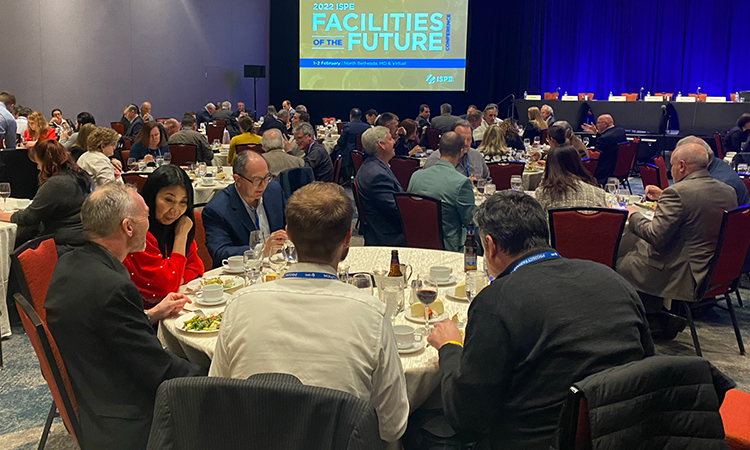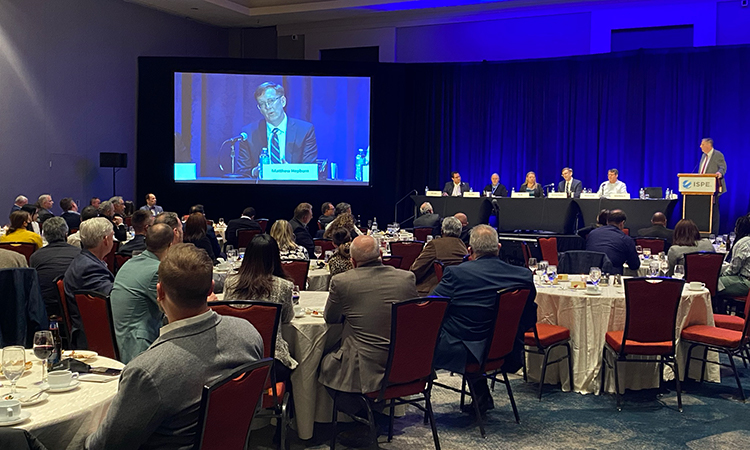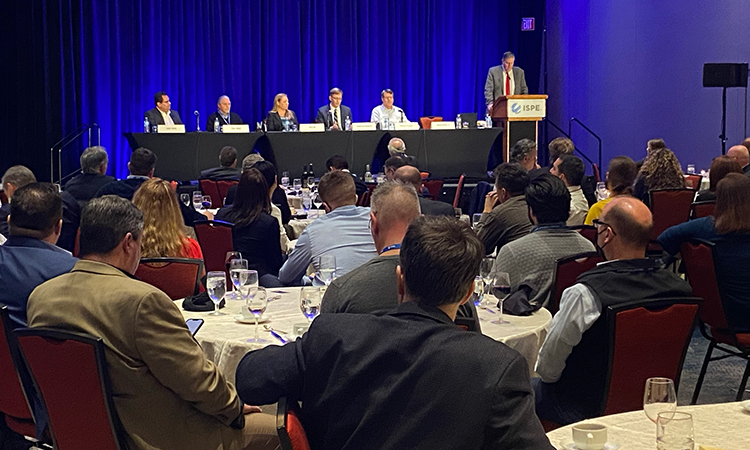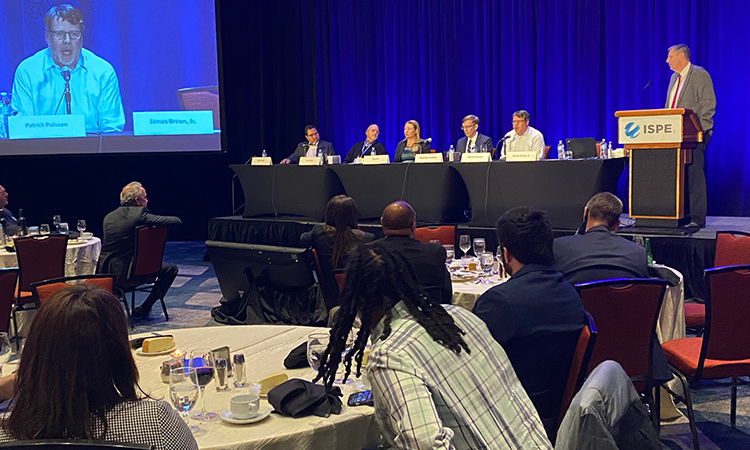Executive Forum Panel Discusses Future Pandemic Planning & Other Topics
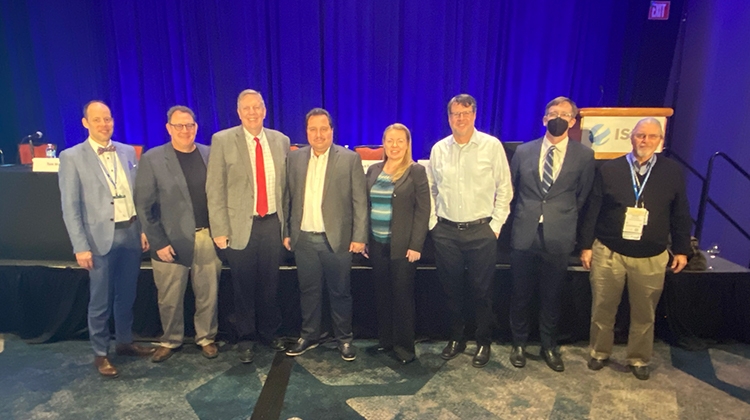
2022 ISPE Facilities of the Future Conference
Executive Forum Panel Discusses Future Pandemic Planning & Other Topics
The Executive Forum Panel at the 2022 ISPE Facilities of the Future Conference provided discussion and consideration of a range of industry issues, including current technologies, addressing misinformation about vaccines and other pharmaceuticals, and how the industry can prepare for the next pandemic.

The Panel convened Tuesday evening 1 February at the end of the first day of the conference. The discussion was moderated by James A. Breen Jr., PE, Vice President, Lead Biologics Expansion, for Janssen Pharmaceuticals.
Panel members were:

Discussion Highlights
Here is a summary of the discussion during the question and answer session (note that questions may be paraphrased for clarity).
What technologies and tools should be focused on to prepare for career in the pharmaceutical industry?
Velez said that learning all that you can, never saying no, and learning a little bit of everything “will open doors for you.” Warf noted that the conservative approach he learned while working at Merck has been foundational for him through his career to this day. “Think about what you do, how it’s getting done, and decide if you would take that product and put it in your child’s arm,” Warf said. “Do risk analysis before making recommendations—doing harm in this business is very bad and can have long consequences. Worry about quality and safety first of the product that is going in people’s arms or mouths. Something new and different should improve quality and safety and be better” than a product it replaces.
How can the industry reduce false claims from misinformation being circulated on social media and other platforms? How do we provide visibility to truth and facts in emerging technologies?
“This has been tearing us apart in this pandemic,” said Hepburn. The societal divisions during the COVID-19 pandemic were not expected in applying lessons learned from the H1N1 pandemic to the responses employed for the current pandemic. “We assumed it would be humanity against the virus, the virus would be the common enemy, and we would unite as nation and global community.” That did not happen so Hepburn and others he is working with on pandemic response are trying to understand the current situation and going forward. The issue seems to be about trusting the sources of information and what information is considered reliable.
Hepburn noted that during Operation Warp Speed, there was a lot of information about the goal to accelerate vaccine development as fast as possible without sacrificing quality and the message was repeated. While he feels that consistent and clear messages like this can be very compelling, there is a lot of misinformation and disinformation out there and that needs to be addressed. “Communicate clearly, adhere to quality, consistency in performance—in your industry, you did maintain that standard of quality and I think that is very consistent in the industry. If the American people truly understood how consistently the quality standard is adhered to in the industry, there would be more faith not just in COVID products but in products in general.”
Ek noted the increased collaboration between government agencies and industries in the last two years. “If we speak more about that, and continue working like this, we can get products out faster and assure what we have said—we would not produce anything of a quality we would not take ourselves and give to our families.”
Poisson’s company has developed a new technology; he commented on timing and facilities for that technology.
Poisson gave an overview of the first transplant of a genetically modified pig heart into a human; the heart was developed by United Therapeutics with University of Maryland. This huge medical milestone may save many lives as so many people are awaiting organ transplants, he noted. The company has been working to develop alternative solutions to human organs in its Xenotransplantation programs . He said the enormous technical challenges involved over 10 years of work to get the gene modifications in place. Facilities requirements included breeding pigs in a controlled setting, protective environments, all ground-breaking work.
“In some ways we are paving our own way in investing things to solve issues that haven’t been solved before,” Poisson observed. “Five or six years ago, cell therapy was happening; this is the next wave, and will solve a lot of problems. These are the types of technologies that are emerging now.”
What future impacts in a pandemic from closing borders/issuing vaccines? Is decentralization planned?
Velez recounted J&J’s process in getting its vaccine produced during the current pandemic; it committed to producing a billion doses but had to develop a network of partners to produce the vaccine. The greatest challenge was obtaining single-use items: “they were like gold last year.” There were challenges with some CMO partners who needed support on GMP challenges. Diversification of supply and possibly needing additional locations were lessons learned.
Warf noted that pandemic preparedness should assume borders will be closed in a pandemic, especially influenza. He observed that manufacturing vaccines is hard and it is difficult to do in multiple countries. He said, “It is like building airplanes to make vaccines—a mistake has serious consequences and loss of faith and trust.”
Hepburn agreed, and made note of the great partnerships of the government team with the industry. “This was great and professionally satisfying. All had the same mission, a sacred mission. We were all in this together. Thank everyone in this audience. I hope we can create that teamwork beyond the COVID response” to work on addressing other global health issues. “We need to clearly state a global pandemic requires a global solution. Another thing I enjoyed about Warp Speed when we started May 2020 that even on day 1, we were planning distribution.” The points out the importance of planning and analysis of all steps start to finish early on.
What are the panelists looking at for supply chain for the next pandemic?
Poisson shared some of his company’s experiences and the challenge of supply chain over the past two years. “We make orphan drugs, we are not a big company, we do not have a lot of buying power—so we have been hand to mouth on a lot of raw materials.” Keeping two years of drug product inventory has been an important strategy “because of the products we make: if people can’t take them, it will harm theme.” This was before the pandemic; “when the pandemic hit, I felt a lot better about that strategy because it was a bit contrarian. We’ve had to adapt like everyone has; even in March to April 2020, we shut our buildings and only manufacturing staff went in. There was no playbook. Supply chain continues to haunt us. I don’t know what the solution is; it is a very complicated situation and I don’t want to go through it again.”
Revisiting strategy on the supply network is needed, Velez said, including considering investments in US production. Warf said supply chain issues with expected and so investments were made as soon as funds were available. He suggested a policy to protect the manufacturing base to critical supplies for the country could help. Ek noted that ISPE has been looking at the global perspective and supply chain needs to be addressed on a global basis.
The complexity and unpredictability of this challenge make it hard to solve, Hepburn agreed. A complex balance is needed of what government can do, when it should intervene, and how to solve the issue, with the goal of less disruption. Multiple suppliers or interchangeable parts can help; government may be able to assist in regulatory processes to understand what is needed to show that an exchange is acceptable.
With that said, Hepburn said he is “fairly optimistic” that the “new normal” of being responsive and changing approaches such as at-home diagnostics and telehealth may be here to stay. “If we are able to develop a vaccine/therapeutic for COVID, why can’t we do it for “fill in the blank” because those people are suffering too.” Although the rapid response to this pandemic created strains on pharmaceutical manufacturers and the government, he asserts that it should be possible. Warf said this would need a paradigm change, acknowledging that Hepburn’s job is different from the way things were after the H1N1 pandemic, but wonders how long the changes can be sustained.
How should pharmaceutical manufacturers approach sustainability in facilities of the future?
Poisson said his company is committed to sustainability, including its facility in Silver Spring, MD and a new net zero carbon facility being built in North Carolina. “Corporations have a responsibility to pursue the least amount of impact on environment, and environmental social governance (ESG) is now being included in SEC filings in big companies,” he said. Expectations are ramping up and with new facilities, you should consider how much energy you can take from sustainable sources, where building materials are coming from, and sustainable sources. Especially with solar energy advances, he said it is possible to build a GMP facility with its own energy.
Velez said J&J has committed to protecting the environment and working toward being 100% powered by renewable energy, with this being addressed in every new facility. “LEED is not enough anymore—we need to go beyond it.”
How is culture helping the industry to do better? What culture would you expect in your company, your partners, and government agencies?
“We’ve been talking about company culture for so long,” Ek said. “As many speakers said, we’ve seen for the last few years about how good culture and collaborations have worked for us. Also in interacting with government, the importance of people in all different roles and companies feeling empowered to make decisions, and leadership being available to make the calls to get things moving. We’ve learned a lot about this. The way forward for this industry is going back to those core values.”
“It does obviously make a difference,” Hepburn said. “Working in government, you get to see a lot of different companies; with Warp Speed, we saw a lot of companies working toward a goal. Culture does make a difference in product development. Culture and professional development are linked. Part of workforce development is teaching people good habits. We’re trying to think about this internally in government, hope we can reform. The pandemic offers a unique opportunity to change things for the better.”
Disclaimer
This is an abridged, unofficial summary of a panel discussion session at an ISPE conference. It includes comments from government employees that have not been vetted by any government agency, office, or group. The article contains an informal and brief synopsis of the panelists’ views, and does not represent official guidance or policy of the United States government or any government agency, office, or group.




